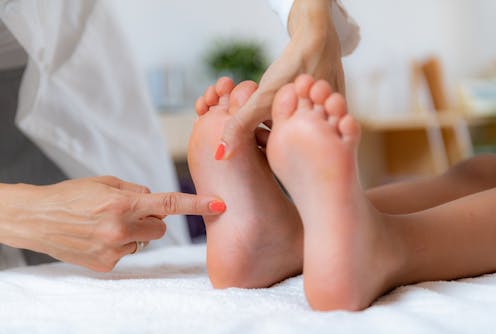
For many decades, if not centuries, researchers, medical professionals and the general population have believed that people with flat feet are more prone to developing a variety of problems.
Specifically, having flat feet was believed to predispose individuals to future pain and other musculoskeletal problems (i.e. to muscles, tendons and/or ligaments).
Flat feet were believed to be a kind of time bomb.
However, in a recent editorial published in the British Journal of Sports Medicine, my research team challenges this myth. We demonstrate that the theory that having flat feet inevitably leads to pain or other musculoskeletal problems, is unfounded.
As a researcher in podiatric medicine at the Université du Québec à Trois-Rivières (UQTR), I will explain the main conclusions of our study here.
Table of Contents
Where does this theory come from?
The idea that flat feet are a problem dates back centuries.
It was revived in the second half of the 20th century by the American podiatrists Merton L. Root, William P. Orien and John H. Weed, who popularized the concept of “ideal” or “normal” feet.
These clinician-researchers were the first to propose that if feet did not meet the specific criteria of normality (for example, a well-defined plantar arch, a straight heel in line with the tibia) they were abnormal, less efficient and more prone to injury because of multiple biomechanical compensations, such as greater arch flattening while walking.
This theory became central to the educational programs of health professionals. Although today it is gradually disappearing as modern curricula are updated, the theory was taught for almost five decades throughout the world, even though the scientific basis was weak. In fact, science has never validated the theory: it has remained at the hypothesis stage.
Nevertheless, over the years up until the present, many health professionals have continued to support the theory that flat feet pose a major risk for developing musculoskeletal disorders.
As a result, this idea is still firmly anchored in the beliefs of the general public.
Do flat feet cause musculoskeletal injuries?
Contrary to the theory of Root and colleagues, meta-analyses, the highest level of scientific evidence, have shown no increased risk of developing the vast majority of musculoskeletal injuries among people with flat feet.
These meta-analyses only identified weak links between having flat feet and the risk of developing medial tibial stress syndrome (pain in the tibia), patellofemoral syndrome (pain around the kneecap), and non-specific overuse injuries of the lower limbs.
That’s it.
Furthermore, a systematic review and a meta-analysis concluded that runners with flat feet are no more at risk of injury than those with regular feet.
These analyses call into question the idea that people with flat feet have a substantial risk of developing musculoskeletal disorders.
However, despite these findings, various sources such as grey literature, professional websites, forums and other media, often suggest that people with flat feet run a higher risk of injury, or even require treatment — even when they don’t have any symptoms.
Unfortunately, this frequently results in people having unnecessary interventions, such as using orthopaedic shoes or custom-made foot orthoses for asymptomatic flat feet. It also leads to significant concerns among patients about the appearance of their feet.

(Shutterstock)
Setting the record straight
Asymptomatic flat feet generally do not require the intervention of health professionals. Based on current scientific knowledge, assessing whether a person has flat feet to determine their risk of injury is ineffective and counterproductive.
While it is possible for a person with flat feet to develop a musculoskeletal injury, this does not necessarily mean that flat feet caused the injury.
It is quite possible for two variables to be present at the same time without there being a causal link. There is an important difference between a causal link and a correlation. A cause-and-effect relationship implies that a change in one variable (the cause) leads to a change in another variable (the effect). When two variables are correlated, changes in one variable may be associated with changes in the other, but this does not mean that one causes the other.
To illustrate the concept, let’s take the following example: we give 500 children aged six to 12 the same math test. By carrying out correlation tests, we notice a trend: the bigger the children’s feet, the higher their final mark in the exam.
This raises the question, does foot size really influence mathematical skills? Of course not!
Another variable that is not taken into account, age, plays a major role in this correlation. Since feet get bigger as we grow older, there is a strong but false correlation!
The same principle applies to flat feet. If a musculoskeletal injury occurs in a person with flat feet, current research indicates that flat feet are not necessarily the cause and that other factors need to be explored.
The link is one of correlation, not cause and effect.
Reducing overdiagnosis in health care
Reducing overdiagnosis in health care has become crucial. This phenomenon, defined as the diagnosis of a condition that brings no net benefit to the individual, constitutes a global burden with potential adverse effects on patients’ physical, psychological and financial well-being.
In financial terms, it is easy to understand that prescribing custom-made foot orthoses costing hundreds of dollars to prevent musculoskeletal injuries associated with asymptomatic flat feet, has a substantial negative impact. This is especially true given that the presence of flat feet only slightly increases the risk of developing these injuries.
To solve this problem, health-care professionals must help to reduce the overdiagnosis of flat feet by making a clearer distinction for their patients between harmless anatomical variants, and conditions of potential concern.
Since overdiagnosis often leads to overtreatment, avoiding unnecessary treatments will help to alleviate patients’ concerns about their flat feet.
Finally, we must abandon the outdated idea, still widespread, that says having flat feet is a problem that exposes individuals to a high risk of musculoskeletal injury. It’s time to change our perspective and our approach to the significance of flat feet and to recognize their natural diversity in the context of overall foot health.
Above all, it’s time to consider asymptomatic flat feet for what they are…simply an anatomical variant!
![]()
Gabriel Moisan is a member of the Ordre des Podiatres du Québec (College of Podiatrists Québec). He has received funding from the Natural Sciences and Engineering Research Council of Canada (NSERC), the War Amps of Canada and the Réseau provincial de recherche en adaptation-réadaptation (REPAR).























